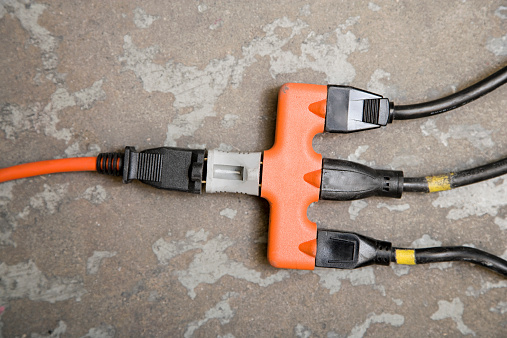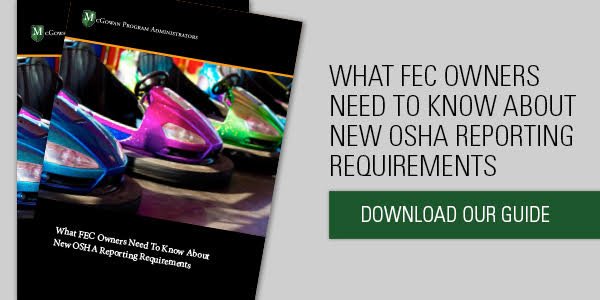The most common, convenient, and easiest way to provide electrical power to an appliance, tool, or piece of equipment that cannot reach an outlet is through an extension cord. These highly common insulated and flexible devices are available in almost any sundry retail store, hardware, or home supply facilities. Consisting of an outlet, plug and length of flexible insulated wiring, extension cords are used in most homes, businesses, industries, and construction.
While providing a great benefit in supplying electricity to where it is needed, the common extension cord is one of the most abused and misused pieces of equipment. They are often used to supply current exceeding their capacity in conditions beyond their design and are more susceptible to damage than fixed wiring.
Extension cords are a leading cause of electrical fires and can cause injury and death if used improperly. According to data from the Consumer Product Safety Commission, the Occupational Safety & Health Administration (OSHA) and the National Fire Protection Association, each year electric extension cords account for:
- 3,300 residential fires killing and injuring over 300 people. The most frequent causes of these fires are short circuits in the cord, overloading, damage, or misuse.
- 4,000 cord related injuries treated in hospital emergency rooms. About half of these injuries are from people tripping over the cord.
- $1.4 billion in property damage.
- 1,100 electrical burns and 1,480 electrical shocks to workers. A large percentage of work related electrical accidents on construction jobsites. A large proportion of structure fires are caused by cord damaged or overloading.
These injury and property damage statistics can be avoided through the use of some fairly basic safety practices when using electrical extension cords. Key safety practices include:
Add outlets where needed
Obtain a licensed electrician to install power outlets in those areas where extension cords are used as permanent solutions. A heavy reliance on extension cords is an indication of too few outlets supplying electrical needs. Extension cords are only intended for temporary use, generally defined as not exceeding 90 days.
Select the right cord for the job
Using an under-sized cord for the power demands (overloading) or using a cord not rated for the environment or the application for which it is to be used are very common mistakes. Overloading can cause a cord to heat up to the point that its insulation either melts or carbonizes creating a fire, burn, or shock hazard.
Extension cords are rated in many different ways. The first is where the cord is to be used. OSHA requires three-wire cords designed for hard or extra-hard usage. Hard-service cords are marked with letters such as S, SE, SO, ST.
Light duty cords—or more commonly ungrounded flat-wire cords—cannot be used on construction sites or for industrial/commercial settings because they do not provide the same abrasion and electrical protection as double-insulated heavy-duty cords. Light duty cords should never be used for powering multiple items at the same time, such as space heaters, toasters, or hair dryers that have a high-energy demand and those with exterior metal surfaces that need to be grounded.
When buying extension cords, make sure they have been certified by a nationally recognized testing laboratory such as UL, CSA, or ETL, and read the manufacturer’s instructions carefully to assure the cord will meet your needs.
Extension cords should be selected based on the electrical current it will be required to carry (amperage or amps) and the length of the cord. Using a low amp rated cord for an application requiring a higher power demand will cause the cord to heat. The current carrying capacity of extension cords is determined by the diameter of the wire (gauge) and the cord length. Wire diameter and the number of amps it can carry, increases with a decrease in gauge number.
Protect the cords and those that may contact them
Cord insulation—particularly light-duty two-wire cords—is easily damaged by being pinched between furniture and floors or walls or by being crushed or abraded by foot traffic exposing the energized wires creating a fire and shock hazard. The damage may not be easily visible. If the insulated metal wires are damaged, such as by the cord being crushed in a door, it can form a hot spot creating a fire hazard. For these reasons, the National Electrical Code does not permit cords to pass through wall holes, suspended or dropped ceilings, floors, doorways, windows or similar openings. Similarly, insulation of cords placed close to heating appliances may also be damaged, melting or burning it away.
Repair or replace
Worn, frayed, or damaged cords should be removed from service and destroyed to prevent their re-use. The damaged cord should then be replaced with a new cord.
Inspect
Due to their high use and high abuse, extension cords should be visually inspected for damage prior to each use on any work shift and when their electrical current use changes such as adding additional power sources or relocating the cord to a new outlet. Look for external defects such as:
- Deformed or missing pins
- Missing grounding pins
- Damage to outer jacket or insulation
- Loose plug or receptacle ends
- Pinched or crushed outer jacket
- Broken plug head
- Use of duct or electrical tape
Verify that the right type and length of cord is being used for the application, environment, and power demands. Check the outer jacket and cord ends. If they feel warm or hot, immediately discontinue cord use. This may indicate overloading or internal damage. Internal damage may also be present if the outer jacket was pinched or crushed, the ends are damaged or tape has been placed over the outer covering.
Extension cords provide a convenient way to deliver electrical power where it is needed. These valuable and common devices are also subject to significant abuse and misuse. Misuse and abuse can lead to fires and injuries. Cord users need to select the proper cord and use it safely to prevent these adverse outcomes
When in doubt, engage your electrician or contract out with a licensed electrician. Electricity and power are not to be fooled with and as the statistics evidence above, it can lead to serious injury, even death. For more information about this topic or other risk management ideas contact me at Dtewksbury@mcgowaninsurance.com. Be safe out there!



